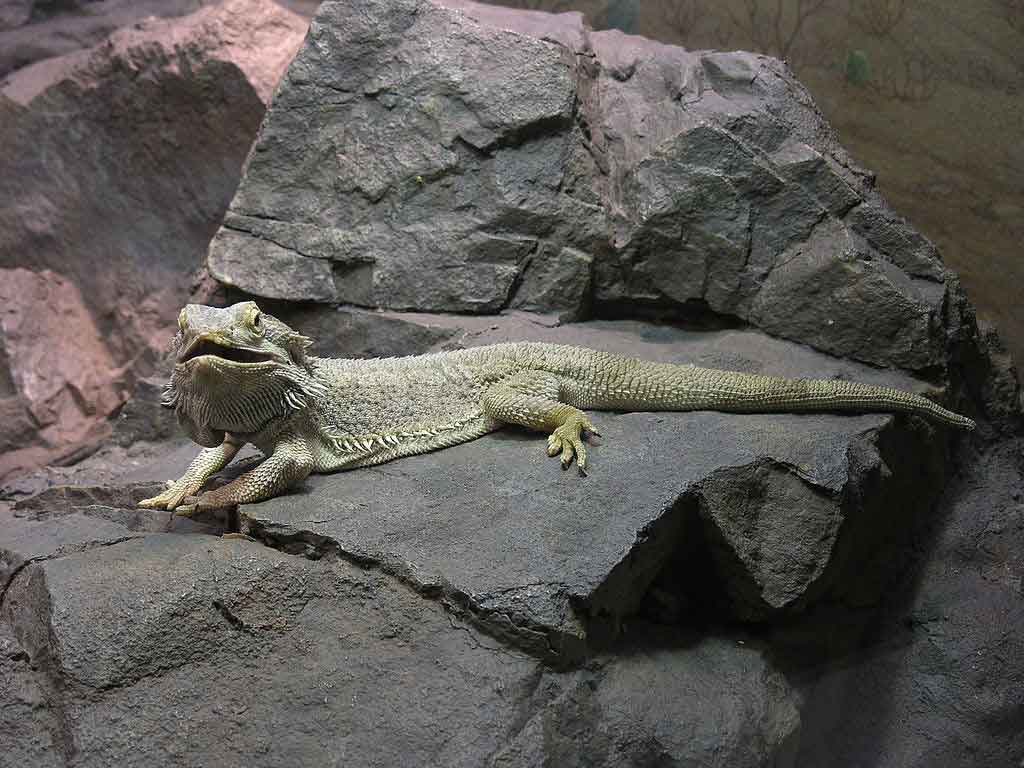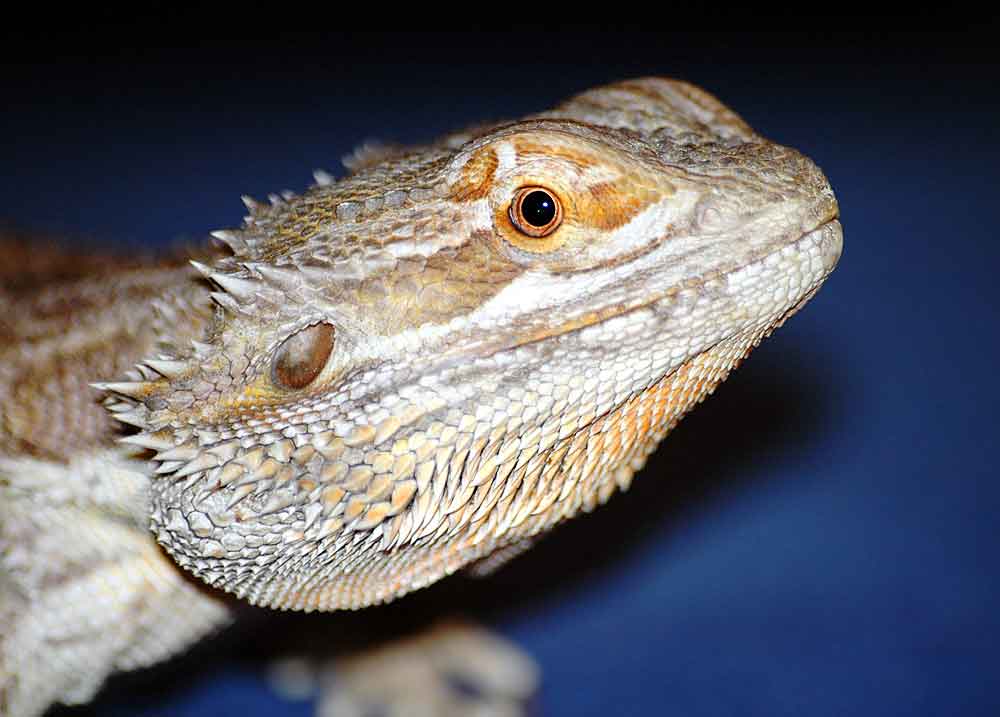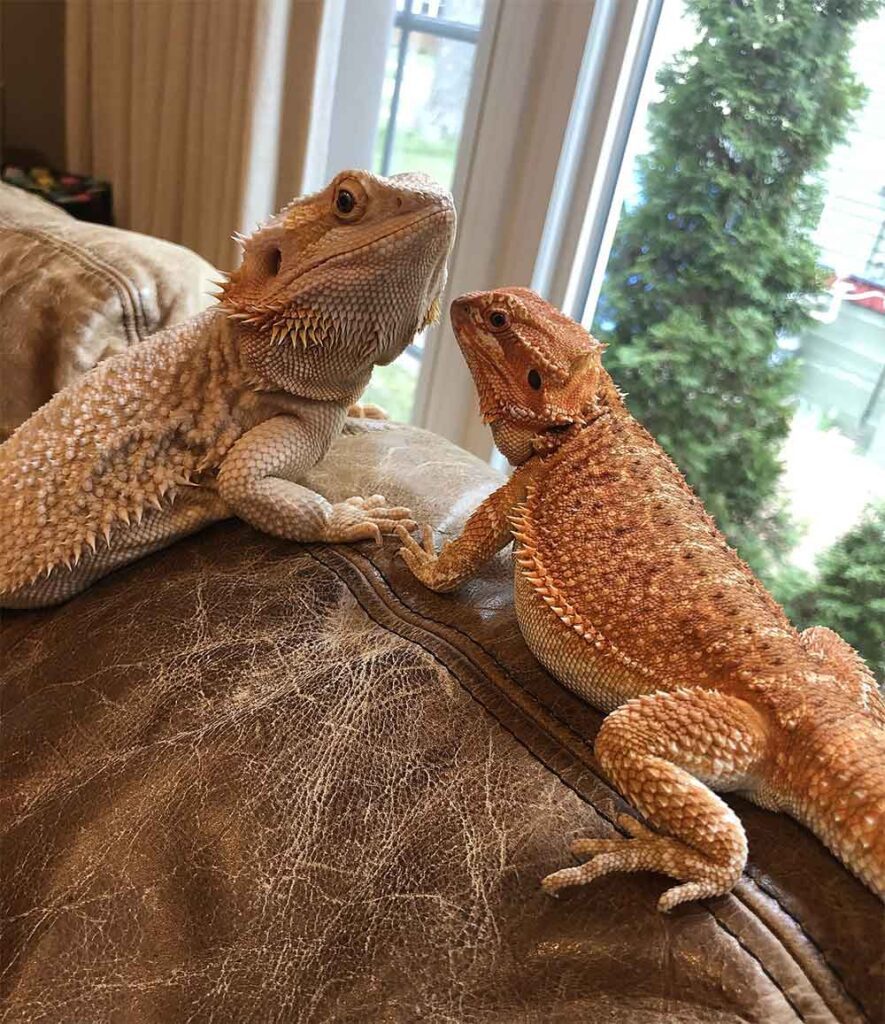Content |
|---|
At present they are known 8 species bearded dragons (Pogona), of which two species are commonly bred in captivity: The “Central bearded dragon” (Pogona vitticeps) and the Rankin's dragon (Pogona henrylawsoni). Although the two species differ considerably in size, breeding requirements are more or less comparable. Visually, The two species are distinguished by the shape of the head and the “thorns”. The spines on the head and flank of the Rankin's dragon they are underdeveloped, While the of the Bearded dragons are clearly visible.
All the bearded dragons that are offered in trade are offspring, and various breeding varieties are now regularly offered as well. Breeding methods questionable from the point of view of animal welfare should be avoided, as the “bearded dragons with reduced scales” (the so-called silk and leather).
Sex differences
Males usually have well-defined pores on the inside of the thighs and clearly visible hemipenis.
Behavior
Both species are diurnal and very active. They can be kept individually very well. Only in sufficiently large and well structured terrariums is it possible to keep them in small harems (a male with 2 – 3 females) or in groups of females only; However, animals should be approximately the same size. Males are usually incompatible with each other. If aggressions occur during socialization, animals must be separated immediately and, as experience has shown, permanently.
The Bearded dragons communicates with gestures; a striking head tilt indicates dominance, while a salute with the front limbs is a gesture of appeasement.
The terrarium

To keep a Bearded dragons, a terrarium of at least 150 x 80 x 80 cm. (length x widht x hight) and, for him Rankin's dragon, of at least 120 x 60 x 80 cm.. These terrarium sizes apply to keeping individual animals or small harems.. But, due to the size and activity of the animals, much larger terrariums recommended.
Like cold-blooded animals, the Bearded dragons you need a temperature gradient in the terrarium that allows you to reach your optimal body temperature. Ideally, imitate the natural conditions of the dry regions of Australia in the terrarium., with areas of bright sun and areas of cooler shade. As such, a powerful heat radiator with UV components is installed on one side of the terrarium (for example, a metal vapor lamp), that guarantees strong localized heating at 45 – 50 °C. All other areas should be kept at a temperature of 22 °C. The other zones should have a temperature of 22 to 26 °C. At night, the temperature in the terrarium can drop to 20 – 23 °C. The basic temperature can be generated through room temperature or with thermal mats. Heating mats should always be installed outside the terrarium and heat a maximum of one third of the floor surface; the desired temperature can be adjusted with the help of a thermocontroller.
The duration of the illumination should be 10 to 14 hours. At the same time, each animal must have access to resting areas of sufficient size at all times. Bearded dragons need a lot of UV light. Since lamps emit less and less UV radiation over time (Consult the manufacturer's instructions), must be replaced periodically. Lighting should be placed out of the reach of animals (attention: normal glass is impervious to UV-B rays) or animals must be protected from burns with a closed wire basket.
The humidity should be 30 to the 40 % and can increase up to 60 % At night. This can be achieved by spraying the terrarium with warm water or using a sprinkler system.. Important: In a small area of ​​the terrarium, the substrate should always be slightly moist. Precise thermometers and hygrometers are needed to measure temperature and humidity.
Stable rock constructions (also imitations), roots and/or branches have proven suitable as furniture. The equipment must be well installed in the terrarium so that the animals cannot be harmed, for example, scrabbling under him. It also, various hiding places (cork tubes, caves) and a shallow bowl of water, in which animals can also bathe, are part of the basic equipment. A dust-free sand and clay mixture is suitable for the substrate, that must have 20 cm high in at least one part of the terrarium so that the animals can dig tunnels as they would in the wild.
Diet

The Bearded dragons feeds on plants and animals in nature. Recent veterinary findings recommend a high proportion of plant foods to prevent gout. So, young animals must be offered a lot of plant food - in addition to insects- and adults must be given at least one 80% vegetable food. The right foods are the grass of the meadows (for example, dandelion, chickweed, etc.), romaine lettuce and small amounts of zucchini, grated carrots or cucumbers. Fruit should not be offered. Live insects, like grasshoppers, cockroaches or crickets, are suitable as food for animals. Mealworms should be avoided, zophobas or wax moths for their high fat content. To prevent deficiency symptoms, minerals and vitamins should be administered regularly (for example, sepia, vitamin-mineral preparations). Fresh water must be available at all times.
Young animals grow very fast and, Therefore, need large amounts of food, as well as a good supply of calcium and UVB light.
Care
Food scraps, molts and droppings should be removed daily. The water bowls should also be cleaned daily and filled with fresh water.
Animal health must be monitored daily. The most common health problems in the Bearded dragons are skin mites, the lesions, the drop, fatty degeneration and softening of the bones. In case of anomalies, a reptile vet should be consulted. It is recommended to perform fecal examinations once a year to detect endoparasites..
The intestinal flora of a Bearded dragons often includes salmonella, that are harmless to animals but can cause disease in humans. Hygiene measures (wash your hands well, etc.) can prevent infection.
Acclimatization and handling
In the first days in his new home, animals need adequate rest to get used to their new environment. Reptiles are normally observation animals and should NOT be petted. But, bearded dragons can become very confident.
Animals should only be captured when necessary. The easiest way to do this with young animals is to use a container. Although handling older trusted animals is relatively easy, it is recommended to handle aggressive animals only with gloves (or a towel). Both the head and the hind legs must be well fixed with the tail. Basically, lizards should never be held or fixed by the tail.
Caution: the Bearded dragons can bite hard.
Breeding
When the brumation comes to an end, the Bearded dragons male goes out to find a partner. There is a courtship ritual in which the male begins to move his head, wave your arms and stomp in front of the female. The male chases the female and bites the nape of her neck and clings to her as he gets into position to copulate.
During the playback period, the females of Bearded dragons can store sperm in oviductal crypts, allowing the female bearded dragon to lay a clutch of 11-30 eggs twice in a single mating.
The Bearded dragons presents a sex determination by temperature. This means that while the embryo is developing, higher temperatures cause dragons with a male genotype to undergo a sex inversion and express a female phenotype. This produces a Bearded dragons that she is a female but still has a male genotype. Incubation temperatures above 31 degrees Celsius can cause reversal of sex, and the probability of sex inversion has a positive correlation with temperature up to 36 Celsius degrees. Incubation temperatures below 31 degrees Celsius cannot cause sex reversal.
Surprisingly, the females of Bearded dragons with male genotype do not present many differences with genotypic females.
According to a study conducted on the bite force, the Bearded dragons male has superior bite force to genotypic females and sex-reversed females. But, there were no differences between genotypic females and sex-reversed females.
Special features
In the wild, the Bearded dragons goes into hibernation during which he is lethargic and does not usually eat. For selective hibernation, lighting duration can be gradually reduced in autumn until turned off (daylight is needed). After 1 or 2 months of actual hibernation, lighting is gradually expanded again.
The Bearded dragons has a high rate of reproduction; females can put up 40 eggs several times a year. So, care must be taken that females receive sufficient rest periods (eventually separation from males). There is currently an oversupply of Bearded dragons and there are hardly any buyers for the young animals. So, the eggs should only hatch if there are safe buyers for the hatchlings.
The price of a Bearded dragons. oscillates around 70 EUR

